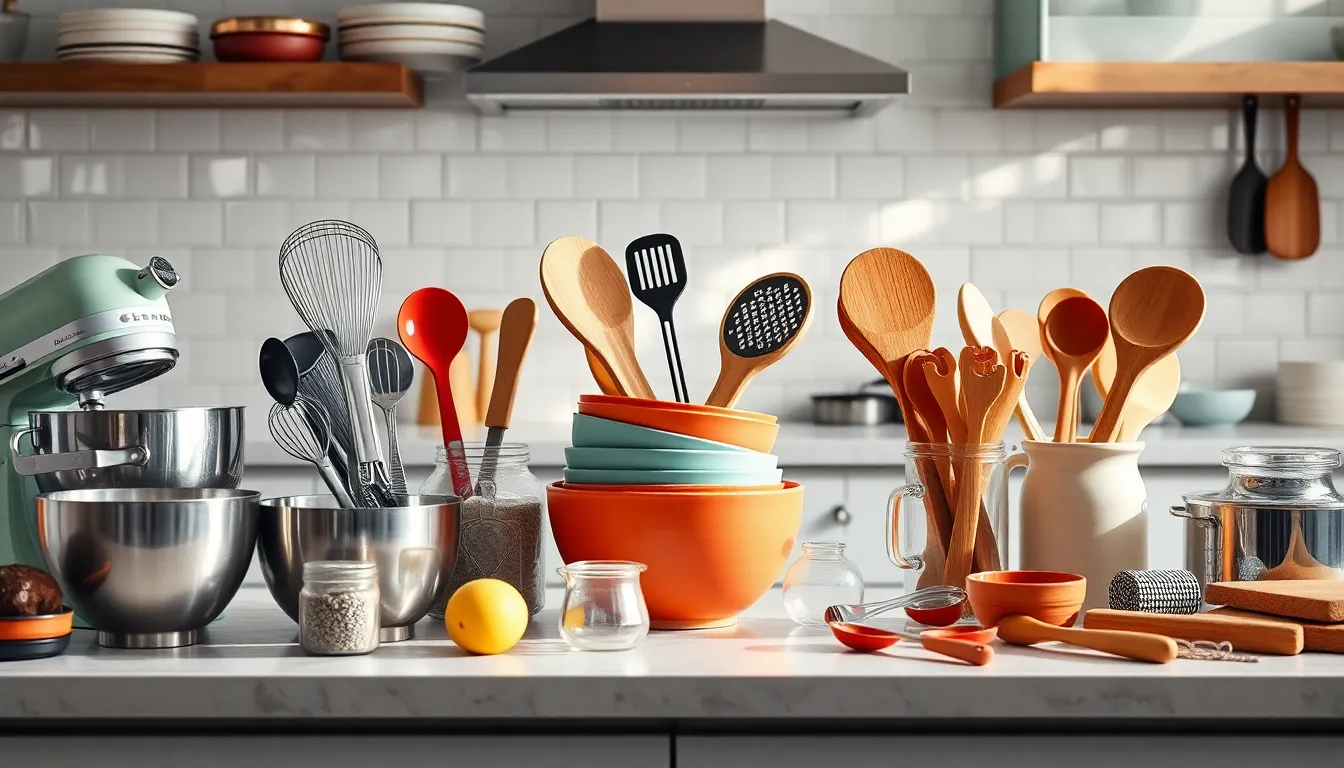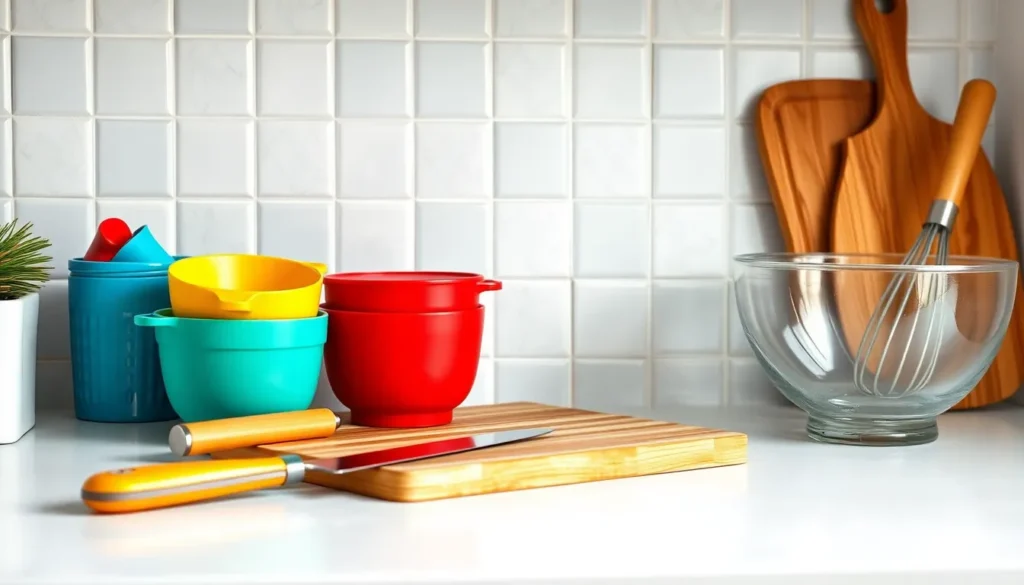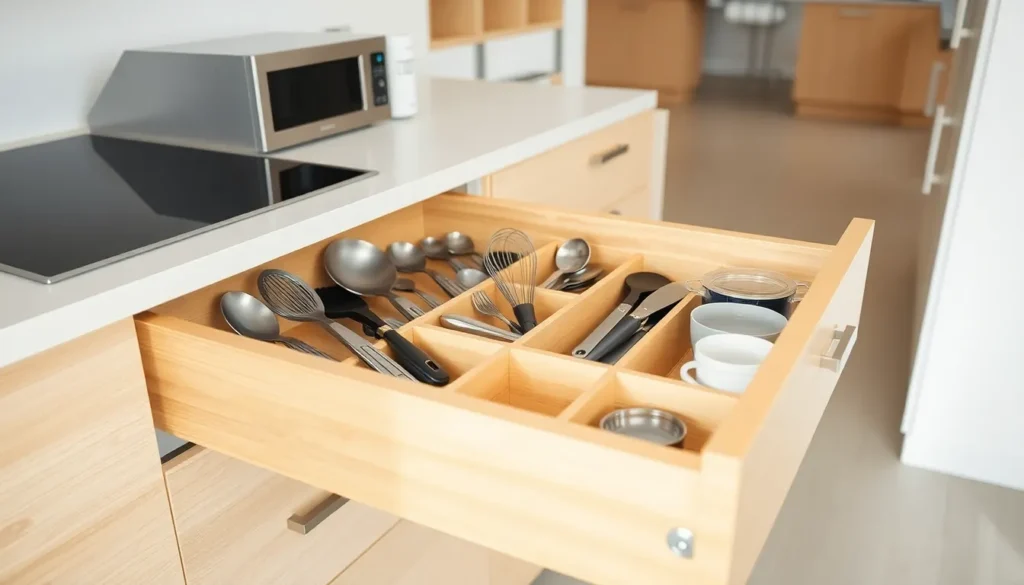Every home cook knows that the right tools can make all the difference in the kitchen. With a vast array of kitchen utensils available, it can be overwhelming to figure out which ones are essential and which are just nice to have. This guide simplifies the process by highlighting the must-have utensils that every kitchen should include, ensuring that cooking becomes a more enjoyable and efficient experience.
From measuring cups to spatulas each utensil plays a unique role in meal preparation. Understanding their functions not only enhances culinary skills but also boosts confidence in the kitchen. Whether someone is a novice or an experienced chef this guide will provide valuable insights into selecting the right utensils to elevate any cooking adventure.
Table of Contents
ToggleEssential Kitchen Utensils
Essential kitchen utensils simplify the cooking process and enhance culinary skills. Various tools serve specific purposes and contribute to efficient meal preparation.
Cutting Tools
Cutting tools comprise knives, cutting boards, and kitchen shears, each serving a unique function in food preparation.
- Knives: Essential knives include chef’s knives, paring knives, and serrated knives. These knives enable precise slicing, dicing, and chopping of various ingredients.
- Cutting Boards: Different cutting boards prevent cross-contamination between raw and cooked foods. Use wood or plastic boards based on the type of food being prepared.
- Kitchen Shears: These versatile tools cut through packaging, herbs, and even poultry. They often feature a built-in bottle opener or nutcracker for added functionality.
Mixing and Measuring Tools
Mixing and measuring tools ensure accurate ingredient proportions and uniform mixtures in cooking and baking.
- Measuring Cups: Liquid measuring cups and dry measuring cups allow exact measurements for recipes. Use standardized sizes, like 1 cup or 1/2 cup, for consistency.
- Measuring Spoons: Tablespoons and teaspoons provide precise measurements for smaller ingredient quantities. These spoons help maintain flavor balance in dishes.
- Mixing Bowls: Nesting mixing bowls in various sizes support multiple preparation tasks. They facilitate mixing, marinating, and storing ingredients.
- Whisk: Whisks effectively incorporate air into mixtures, ideal for beating eggs and emulsifying dressings.
- Spatulas: Silicone or rubber spatulas allow for easy mixing and scraping of bowls, ensuring no ingredients go to waste.
Specialty Kitchen Utensils

Specialty kitchen utensils enhance specific cooking tasks, providing tools tailored for unique culinary needs. Incorporating these utensils leads to improved efficiency and better results in the kitchen.
Baking Utensils
Baking utensils play crucial roles in achieving perfect pastries and bread. Key tools include:
- Mixing Bowls: Essential for combining ingredients. Different materials like glass and metal offer versatility in baking.
- Measuring Spoons and Cups: Provide accurate measures that ensure consistent results in recipes, crucial for baking success.
- Sifting Tools: Tools like sifters and fine-mesh strainers help ensure proper flour texture, preventing clumps and enhancing texture.
- Rolling Pins: Facilitate even dough preparation. Various styles, such as tapered or traditional, cater to different baking needs.
- Silicone Baking Mats: Replace parchment paper, preventing sticking while allowing easy cleanup.
Grilling Tools
- Grill Tongs: Offer secure handling of food while flipping or removing items from the grill.
- Spatulas: Flat and wide spatulas are perfect for turning burgers or delicate fish fillets, ensuring even cooking.
- Basting Brushes: Apply marinades or sauces to meats, enhancing flavor and moisture.
- Skewers: Stainless steel or wooden skewers allow for kabobs or grilling vegetables easily.
- Grill Thermometers: Ensure meats are cooked to the right temperature for safety and quality, preventing undercooked or overcooked dishes.
Choosing the Right Kitchen Utensils
Selecting suitable kitchen utensils impacts cooking efficiency and enjoyment. Each utensil’s material, size, and functionality play a critical role in the choice.
Material Considerations
Choosing the right material affects durability and performance of kitchen utensils.
- Stainless Steel: Offers strength and resistance to rust. Ideal for knives, mixing bowls, and cooking utensils. It’s non-reactive, making it safe for acidic foods.
- Wood: Gentle on cookware and provides a classic aesthetic. Popular for spoons and cutting boards. Wood can retain bacteria if not properly cared for.
- Plastic: Lightweight and often colorful; suitable for measuring cups and mixing bowls. Must be BPA-free to ensure safety.
- Silicone: Heat-resistant and flexible, perfect for spatulas and baking mats. Silicone doesn’t scratch non-stick cookware, preserving its lifespan.
- Glass: See-through and non-reactive, suitable for measuring cups and mixing bowls. Glass can break easily, so handle it with care.
Size and Functionality
Selecting the appropriate size and functionality enhances cooking precision and ease.
- Knives: A chef’s knife typically ranges from 8 to 10 inches, perfect for most chopping tasks. Paring knives, about 3 to 4 inches long, excel at peeling and intricate work.
- Cutting Boards: Opt for larger boards (at least 16×20 inches) for multitasking. Smaller boards are convenient for quick tasks, but may not suit larger preparations.
- Measuring Cups: Use specialized dry and liquid measuring cups for accuracy. Liquid measuring cups often have pour spouts and are usually marked in both metric and US customary units.
- Spatulas: Choose a flexible turner for flipping, while a solid one yields better control over mixing batters and scraping bowls.
- Mixing Bowls: Selection should include various sizes: small for ingredients, medium for mixing, and large for tossing. Each bowl aids in maintaining organization during meal prep.
Evaluating these criteria ensures that your kitchen utensils support desired culinary outcomes effectively.
Caring for Your Kitchen Utensils
Caring for kitchen utensils ensures long-lasting performance and hygiene. Proper maintenance techniques help preserve their functionality and appearance.
Cleaning Tips
Cleaning utensils promptly prevents the buildup of food residues. Use hot, soapy water for most tools, rinsing thoroughly to remove any soap residue. For wooden utensils, hand wash them only; soaking can warp or crack the wood. Use a mix of baking soda and water for stubborn stains on plastic utensils. Avoid abrasive sponges, as they can scratch surfaces, particularly on non-stick cookware. Dishwashers are suitable for many utensils, but always check for compatibility with manufacturers’ instructions.
Storage Solutions
Proper storage prolongs the life of kitchen utensils and keeps the kitchen organized. Use drawer dividers to separate utensils, enabling easy access and preventing damage. Hang utensils on a wall-mounted rack for efficient space utilization, especially for frequently used tools. Opt for utensil jars on countertops, creating a visually appealing display while keeping items readily available. Additionally, store knives in a magnetic strip or knife block, minimizing dulling from contact with other utensils.
Equipping a kitchen with the right utensils is essential for anyone looking to enhance their cooking experience. By understanding the unique functions of each tool and selecting them based on material and size, home cooks can streamline their food preparation and achieve better results.
Caring for these utensils ensures they remain effective and hygienic, contributing to a more enjoyable cooking environment. With an organized kitchen and the right tools at hand, anyone can boost their culinary skills and confidence, making cooking a delightful and rewarding endeavor.













